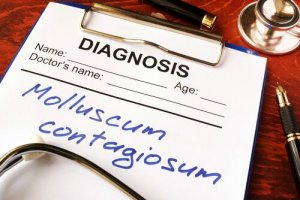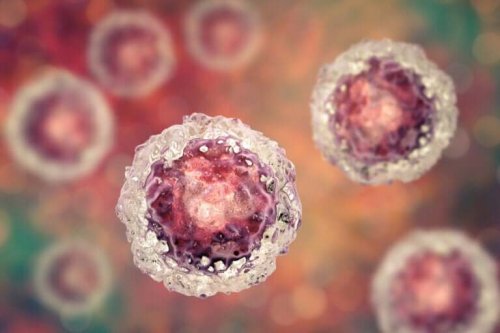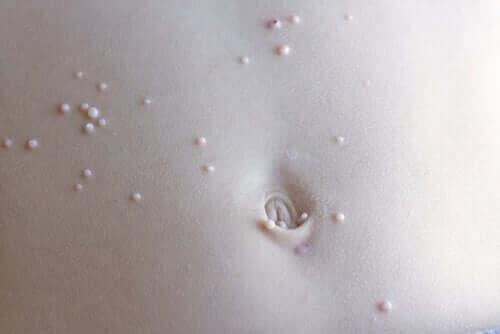What is Molluscum Contagiosum?

Molluscum contagiosum (sometimes called water warts) is a viral infection and therefore contagious. It’s caused by a type of virus known as poxvirus. This infection is increasing in people with active sex lives and in patients carrying the human immunodeficiency virus.
Infection with this virus produces small bumps on the skin that manifest as lesions. It spreads easily. You can contract it simply by being in contact with the infected area or during sexual intercourse. However, it isn’t a dangerous infection and can disappear spontaneously.
It can be treated, as we will see later. Molluscum contagiosum occurs more frequently in children, sexually active adults, and people with weakened immune systems, such as patients with the human immunodeficiency virus.
Molluscum contagiosum: skin infection
As we mentioned before, poxvirus causes molluscum contagiosum – an infection that grows on the skin. It’s a virus that can easily spread and that children and adults can contract.
You can contract it through sexual contact, as well as through non-sexual contact like sharing clothes or towels. Everyone can contract it, no matter your age or sex.
Lesions generally appear on the face, neck, armpits and the tops of hands. However, they can also form on the genitals, on the lower abdomen or the upper inner thigh if the infection was transmitted sexually.
It forms on the skin as lumps or bumps. They aren’t usually painful, but can be irritating. Here are some other characteristics of these viral lumps:
- They’re raised, round, and skin-colored
- Can become red and inflamed as well as itchy
- They can fall off when scratched or itched, making it easier for the virus to spread to other areas of the skin

How to prevent it
Just like other viral infections, you can avoid contracting molluscum contagiosum in different ways, including the following:
- Avoiding contact with affected areas of the skin: either another affected person or yourself, as we can transmit it to other parts of our bodies.
- Washing your hands regularly is one of the best ways to prevent this infection.
- Taking care during sexual intercourse. As we mentioned earlier, it’s one of the ways in which this virus can be transmitted. Therefore, if we know that we’re infected or that the person we’re going to have sex with is also infected, then we should avoid them until the lesions have completely disappeared, or take the necessary precautions to reduce direct contact.
- Don’t share personal items such as clothes, towels, hairbrushes, and more.
Finally, covering the lesions with gauze is a good way to prevent spreading it. This way you can prevent other infections by avoiding direct contact with the lumps.

What are the best treatments for molluscum contagiosum?
As we know, this infection can disappear on its own. However, you can treat it to get rid of it quicker. Treatments depend on the patient’s characteristics, as well as how the disease presents itself. We’re referring to the patient’s immune system when speaking about characteristics.
Therefore, when the disease doesn’t go away on its own, we can choose between these treatment options:
- Scraping – by using dermatological techniques
- Freezing by cryotherapy
- Through pharmacological treatment
- Laser removal
This may interest you: 15 natural remedies for fungal skin infections
Conclusion
Molluscum contagiosum is a viral infection that spreads very easily. Therefore, it’s essential to always follow good prevention guidelines.
However, it’s not a very serious infection and it usually resolves itself, even though different treatments for it. You can consult your doctor if you have any questions.
All cited sources were thoroughly reviewed by our team to ensure their quality, reliability, currency, and validity. The bibliography of this article was considered reliable and of academic or scientific accuracy.
- Uzuncakmak, T. K., & Karadag, A. S. (2018). Molluscum contagiosum. In Diagnostics to Pathogenomics of Sexually Transmitted Infections. https://doi.org/10.1002/9781119380924
- Chen, X., Anstey, A. V., & Bugert, J. J. (2013). Molluscum contagiosum virus infection. The Lancet Infectious Diseases. https://doi.org/10.1016/S1473-3099(13)70109-9
- Olsen, J. R., Gallacher, J., Piguet, V., & Francis, N. A. (2014). Epidemiology of molluscum contagiosum in children: A systematic review. Family Practice. https://doi.org/10.1093/fampra/cmt075
This text is provided for informational purposes only and does not replace consultation with a professional. If in doubt, consult your specialist.








